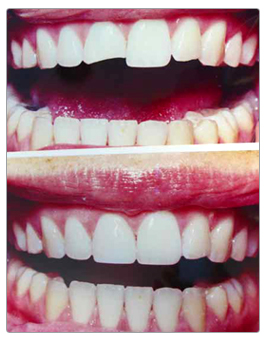| Smile
Gallery - Cosmetic
Dentistry -
Bonding
Dental bonding , also known as composite or tooth
bonding, is an excellent way to fix cosmetic and structural
imperfections in the teeth. Dental bonding can repair
cracked, chipped, and discolored teeth as well as
replace silver amalgam fillings. Cosmetic bonding
can also repair misaligned teeth, providing a straighter,
more uniform smile.
The Tooth Bonding Procedure
To begin the teeth bonding procedure, the dentist
selects a composite resin ( dental bonding material)
that matches the natural shade of your teeth. The
dentist then roughens the existing tooth so the resin
can adhere properly. Next, the composite resin is
carefully applied to the tooth, shaped, and smoothed
to achieve the desired look. It is then quickly hardened
via a high intensity light. Lastly, the bonded tooth
is buffed and polished so it has the same appearance
as the surrounding teeth.
Teeth bonding can usually be completed in one office
visit, depending on the extent of repair needed. Even
if treatment needs to be performed over two or more
visits, you will be pleased to notice a significant
difference in your smile after the first treatment.
A cosmetic dentist can work out an individual plan
for your dental bonding needs after a consultation
and initial dental examination.
Benefits of Cosmetic
Bonding
Tooth bonding offers several benefits for patients.
It is quick, affordable, relatively painless, and
long lasting. Dental bonding is also a great alternative
to more extensive cosmetic dentistry treatment with
porcelain veneers, bridges, and crowns. Additionally,
the composite resin used in a cosmetic bonding procedure
is very flexible, expanding and contracting with the
natural tooth to prevent cracks and tooth loss. Dental
bonding is an excellent option for individuals looking
to repair imperfections in their smile.
Cost of Dental Teeth
Bonding
Financing for cosmetic dentistry procedures is a primary
concern among patients. For dental tooth bonding,
the cost varies depending on the number of teeth that
are repaired and the area of the country in which
the procedure is performed.
Many insurance carriers cover teeth bonding, especially
if it is done for structural reasons. Many cosmetic
dentists have financing plans available for patients,
so a procedure like tooth bonding can be affordable
to patients of all financial backgrounds. Because
dental bonding can easily align, straighten, whiten,
and improve the overall appearance of your smile,
the result is usually well worth the cost.
There are two types of
bonding. What type is indicated in your situation
depends upon whether you have a small area or a larger
area that requires correction.
For small corrections
These are one appointment fillings which are color-matched
to the tooth and are bonded to the surface for added
strength. These are most appropriate for small fillings
and front fillings as they may not be as durable for
large fillings.
For larger corrections
Dental lab-created tooth-colored fillings require
two appointments and involve making a mold of your
teeth and placing a temporary filling. A dental laboratory
then creates a very durable filling to custom-fit
the mold made from your teeth. These fillings are
typically made of porcelain. The custom-fit filling
is then bonded to your tooth on your return visit.
This type is even more natural looking, more durable
and more stain resistant.
|